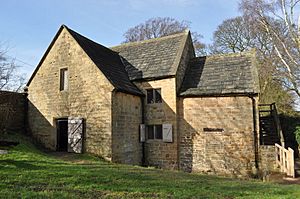Stainsby Mill facts for kids
Quick facts for kids Stainsby Mill |
|
|---|---|
 |
|
| Type | Watermill |
| Location | Stainsby |
| OS grid reference | SK 45562 65319 |
| Area | Derbyshire, England |
| Built | 1846–1850 |
| Owner | National Trust |
|
Listed Building – Grade II
|
|
| Official name: Stainsby Mill | |
| Designated | 22 August 1969 |
| Reference no. | 1052316 |
| Lua error in Module:Location_map at line 420: attempt to index field 'wikibase' (a nil value). | |
Stainsby Mill is an old watermill in Derbyshire, England. It was built in the 1800s to grind flour. Today, this amazing mill works just like it used to! It's a special building, protected as a Grade II listed site. The National Trust, a charity that looks after historic places, owns Stainsby Mill. It's also part of the beautiful Hardwick Hall estate.
Contents
History of Stainsby Mill
People have used a mill at this spot for a very long time. Records show there was a mill here as early as the 1200s! Back then, all the water for the mill came from the River Doe Lea. This river fed into a pond called Miller's Pond on the Hardwick estate.
Later, around 1762, another pond was built. This was the Stainsby Pond, fed by the Stainsby Brook. Water from both ponds flowed into the Mill Pond. This main pond was across the road from the mill itself. Special gates, called sluice gates, let water flow from the pond into the mill's water channel.
Building the Current Mill
By the 1840s, the old mill was falling apart. William Cavendish, 6th Duke of Devonshire, decided it was time for a brand new one. Between 1846 and 1850, the mill was rebuilt using strong stone from the Hardwick Estate. It also got modern machinery for its time.
A huge water wheel, about 17 feet (5.2 meters) across, was installed. This wheel used the power of the water to turn the millstones. The mill worked for a whole century! It finally closed its doors in 1952.
For many years, the Saunders family were the millers, starting in 1689. After 1865, the Hitch family took over. William Hitch was the last miller to work at Stainsby Mill.
Saving and Restoring the Mill
In 1950, the 10th Duke of Devonshire passed away. As a result, Stainsby Mill became part of the Hardwick Estate given to the government. It was then given to the National Trust. This charity started some repairs in 1976.
Later, in 1990, a group called the Ault Hucknall Environment Group looked at the mill's future. They suggested a full restoration. So, in 1991, work began to make the mill fully working again. By 1992, Stainsby Mill was open to the public! Visitors can now see how flour was made long ago.
External Links
- Hardwick Estate: Stainsby Mill – National Trust

